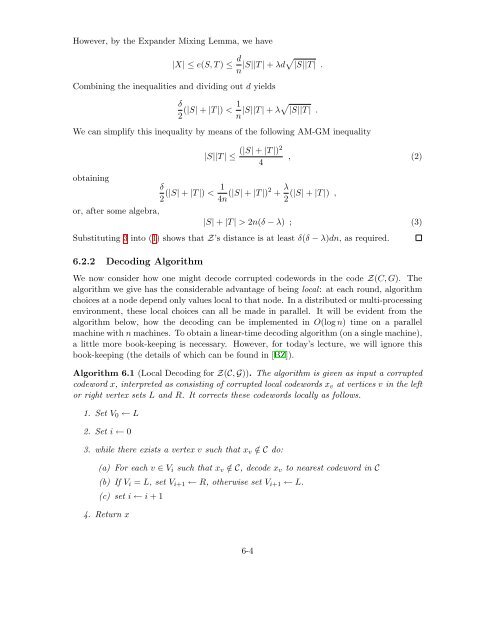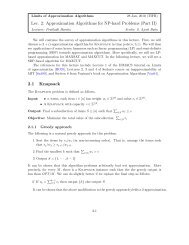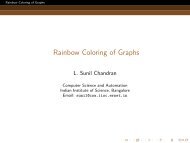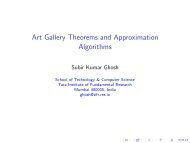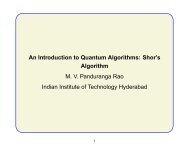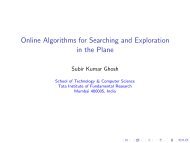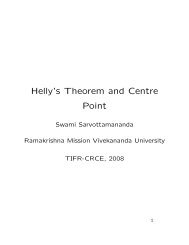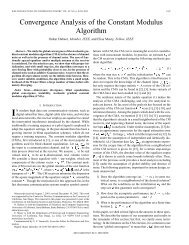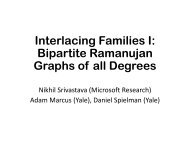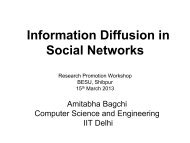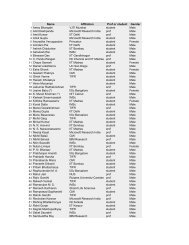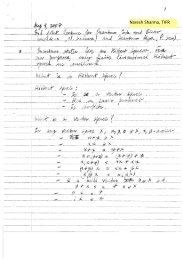Lecture 6: Expander Codes 6.1 Error Correcting Codes â Preliminaries
Lecture 6: Expander Codes 6.1 Error Correcting Codes â Preliminaries
Lecture 6: Expander Codes 6.1 Error Correcting Codes â Preliminaries
You also want an ePaper? Increase the reach of your titles
YUMPU automatically turns print PDFs into web optimized ePapers that Google loves.
However, by the <strong>Expander</strong> Mixing Lemma, we have<br />
|X| ≤ e(S, T ) ≤ d n |S||T | + λd√ |S||T | .<br />
Combining the inequalities and dividing out d yields<br />
δ<br />
2 (|S| + |T |) < 1 n |S||T | + λ√ |S||T | .<br />
We can simplify this inequality by means of the following AM-GM inequality<br />
|S||T | ≤<br />
(|S| + |T |)2<br />
4<br />
, (2)<br />
obtaining<br />
δ<br />
1<br />
(|S| + |T |) <<br />
2 4n (|S| + |T |)2 + λ (|S| + |T |) ,<br />
2<br />
or, after some algebra,<br />
|S| + |T | > 2n(δ − λ) ; (3)<br />
Substituting 3 into (1) shows that Z’s distance is at least δ(δ − λ)dn, as required.<br />
6.2.2 Decoding Algorithm<br />
We now consider how one might decode corrupted codewords in the code Z(C, G). The<br />
algorithm we give has the considerable advantage of being local: at each round, algorithm<br />
choices at a node depend only values local to that node. In a distributed or multi-processing<br />
environment, these local choices can all be made in parallel. It will be evident from the<br />
algorithm below, how the decoding can be implemented in O(log n) time on a parallel<br />
machine with n machines. To obtain a linear-time decoding algorithm (on a single machine),<br />
a little more book-keeping is necessary. However, for today’s lecture, we will ignore this<br />
book-keeping (the details of which can be found in [BZ]).<br />
Algorithm <strong>6.1</strong> (Local Decoding for Z(C, G)). The algorithm is given as input a corrupted<br />
codeword x, interpreted as consisting of corrupted local codewords x v at vertices v in the left<br />
or right vertex sets L and R. It corrects these codewords locally as follows.<br />
1. Set V 0 ← L<br />
2. Set i ← 0<br />
3. while there exists a vertex v such that x v /∈ C do:<br />
(a) For each v ∈ V i such that x v /∈ C, decode x v to nearest codeword in C<br />
(b) If V i = L, set V i+1 ← R, otherwise set V i+1 ← L.<br />
(c) set i ← i + 1<br />
4. Return x<br />
6-4


